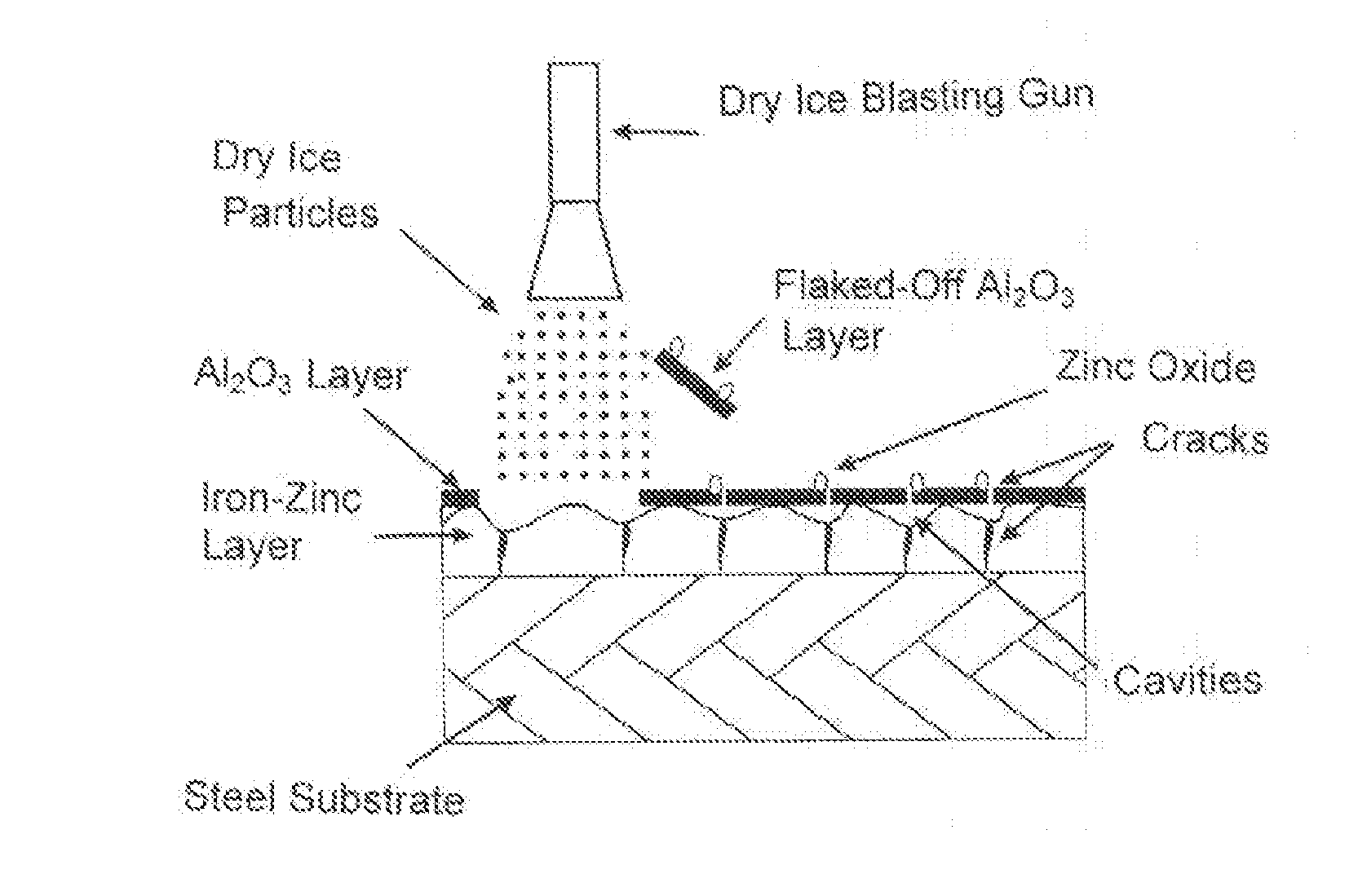Method for the production and removal of a temporary protective layer for a cathodic coating
- Summary
- Abstract
- Description
- Claims
- Application Information
AI Technical Summary
Benefits of technology
Problems solved by technology
Method used
Image
Examples
example 1
[0039]A sheet of 22MnB5 steel 1.0 mm thick is subjected to a preoxidation and a hot-dip coating with approx. 0.2 wt. % aluminum in a zinc bath. The preoxidation is carried out so that a FeO layer thickness of greater than 100 nm but less than 1,000 nm is produced. The galvanizing here is carried out so that a zinc deposit Z200, i.e. 14 μm per side, is achieved. The aluminum content of the inhibiting layer is set to 0.3 g / m2. The sheet is then placed for four minutes in a radiation furnace heated to 910° C., with a normal air atmosphere. As a result, a layer formation according to FIGS. 3 and 5 or according to FIG. 1 occurs. This layer responds favorably to cleaning with dry ice and yields the surface according to FIG. 5 and in subsequent trials, demonstrates the correspondingly favorable paint adhesion.
example 2
[0040]A sheet of 22MnB5 steel 1.0 mm thick undergoes a preoxidation and a hot-dip coating process with approx. 0.2 wt. % aluminum in the zinc bath. The preoxidation of the blank sheet is carried out so that a FeO layer thickness of greater than 100 nm and less than 1,000 nm is produced. The galvanizing here is carried out so that a zinc deposit Z200, i.e. 14 μm per side, is achieved. The aluminum content of the inhibiting layer is set to 0.8 g / m2 and annealing conditions correspond to example 1. As a result, an aluminum oxide-rich surface with little zinc oxide is achieved, which only responds poorly to being cleaned with dry ice. As a result, the surface corresponds to FIG. 6 or before the cleaning, to FIG. 4, and in subsequent trials, demonstrates the poor paint adhesion due to extensive Al2O3 coverage.
example 3
[0041]A steel sheet corresponding to examples 1 and 2 is embodied with a zinc deposit of Z300, i.e. 21 μm per side, instead of a zinc deposit of Z200. On the other hand, the preoxidation of the blank steel band is carried out so that a FeO layer thickness of greater than 100 nm and less than 1,000 nm is produced. The aluminum content of the inhibiting layer is set to 0.3 g / m2. The sheet is then placed for four minutes in a radiation furnace heated to 910° C., with a normal air atmosphere. Here, too, the Al2O3-rich surface not according to the invention forms with little zinc oxide; it responds poorly to being cleaned with dry ice and corresponds to the surface shown in FIG. 4. In subsequent paint trials, a poor paint adhesion is likewise achieved.
[0042]The invention has the advantage that a method for producing and removing a temporary protective layer for a cathodic coating is created, which successfully creates a hardened steel component with a cathodic protection; the cathodic pr...
PUM
| Property | Measurement | Unit |
|---|---|---|
| Length | aaaaa | aaaaa |
| Length | aaaaa | aaaaa |
| Nanoscale particle size | aaaaa | aaaaa |
Abstract
Description
Claims
Application Information
 Login to View More
Login to View More - R&D
- Intellectual Property
- Life Sciences
- Materials
- Tech Scout
- Unparalleled Data Quality
- Higher Quality Content
- 60% Fewer Hallucinations
Browse by: Latest US Patents, China's latest patents, Technical Efficacy Thesaurus, Application Domain, Technology Topic, Popular Technical Reports.
© 2025 PatSnap. All rights reserved.Legal|Privacy policy|Modern Slavery Act Transparency Statement|Sitemap|About US| Contact US: help@patsnap.com



